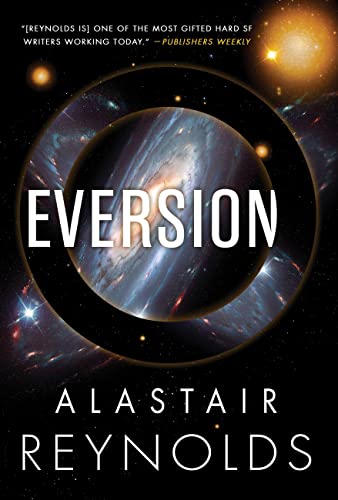Eversion by Alastair Reynolds is a masterful surprise in this author’s work, and I found myself reading it straight through. Instead of opening in one of Reynolds’ future worlds, the action starts on a sailing vessel, the Demeter, in a stormy sea off the coast of Norway in either the late 18th or early 19th centuries. The story of Eversion is narrated by Dr. Silas Coade, ship’s surgeon, who spends his spare time writing stories of a fantastical future. But when disaster strikes the Demeter, the action starts over again, this time on the coast of Patagonia around the mid-19th century. Then the scene shifts to the Antarctic, another fifty years or so in the future, and then it goes beyond that.
The time and technologies shift in each case, but we always encounter the same set of characters in a series of narrations by Dr. Coade, each of which reflects the linguistic style of the era he’s experiencing. In each version of the story, there is also the common search for a strange and enormous structure, referred to as the Edifice, hidden away, either within a barely navigable inlet or deep within a huge cavern far below the surface. Only Silas begins to piece together the resemblances from one version of events to the next, but he has just a few flashes of memory.
It’s hard to say much more about the story without giving away its many surprises. But one of the mysteries at the heart of it is the nature of the Edifice, whose indefinable shape seems to be a partial turning inside out (eversion). The attempt to work out the mathematics of this massive shape, and hence the ability to navigate its intricacies, is the obsession of the young mathematician, Raymond Dupin. His literally feverish preoccupation with solving this topological problem drives him to the point of fever and near death.
The expedition, in its various permutations, is the brainchild of the wealthy and ruthless Topolsky who hopes to make a fortune through the discovery of the Edifice and unearthing its treasures. His security guard is a Coronel Ramos who receives a head wound, which changes somewhat in each version of the story, but he always survives thanks to Dr. Coade’s surgery. The friendship that develops between the two is one of the high points of the novel, as is the conflicted relationship between Coade and the sharp-tongued Ada Cossile. Her role keeps changing in the different versions of Demeter’s search for the Edifice, but she always has a disquieting effect on Coade as she tries to puncture his calm and empathetic manner.
The excitement for the expedition’s leaders in finding the Edifice is shattered, in each version of the expedition, by discovery of a wrecked vessel, the Europa, and its dead crew members. So the crew of Demeter realize they are not the first to reach the Edifice after all, and anger centers on Topolsky, who has concealed the previous expedition from everyone else. In successive versions of the story, the group comes to blows but nevertheless gets closer and closer to setting foot inside the vast structure. However, it appears to be alive in some way and poses more and more danger.
While this adventure moves ahead across multiple times and locations, the confrontations between Coade, Ramos, Cossile, and the others probe more deeply into questions of empathy and what it means to be human. At what point does adherence to a role, however important to the survival of a mission, give way to the human need for connection? What does human identity consist of, in its essence, and when is it legitimate to sacrifice a life for the greater good?
At every stage of this mystery, Reynolds describes the technologies of the various vessels in great detail as well as the increasingly sophisticated instrumentation and mathematics for pinpointing and identifying the big, dumb object that proves so elusive to the explorers. But for me, the most memorable parts of the story, as is often the case in Alastair Reynolds’ writing, relate to the inner drives of the characters he creates and his depiction of a particular type of longing for relationships that are always out of reach.
If you’re a fan of Reynold’s space operatic stories, you’ll need to adjust your expectations, but patience gets a big reward in this perfectly executed novel. Eversion is a finely written science fiction mystery that I could not put down.
I want to thank Orbit and Net Galley for an advance review copy of Eversion as the basis for this review, which reflects solely my own opinions.





Leave a Reply